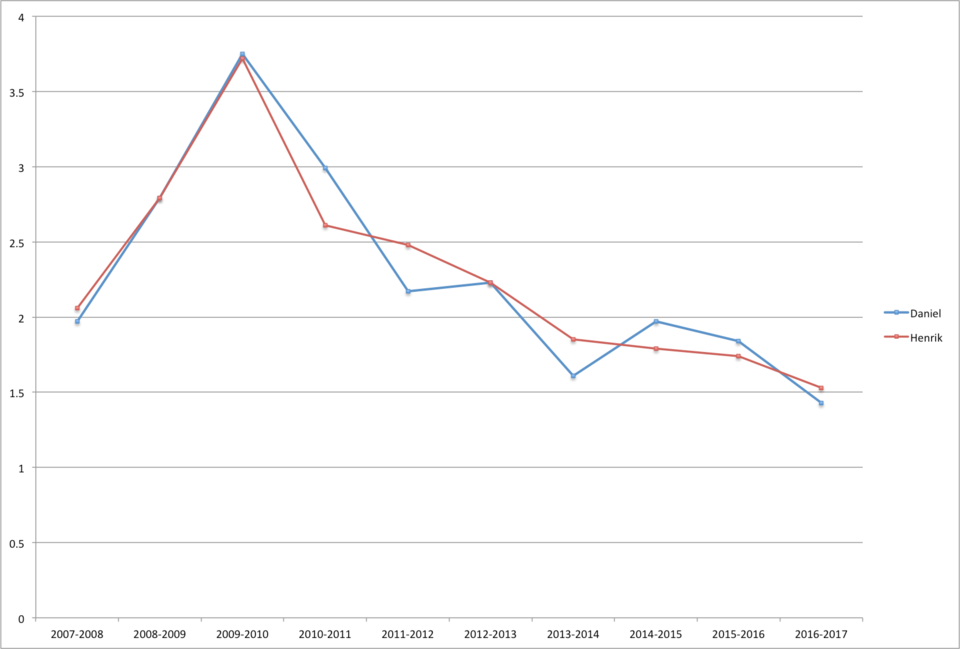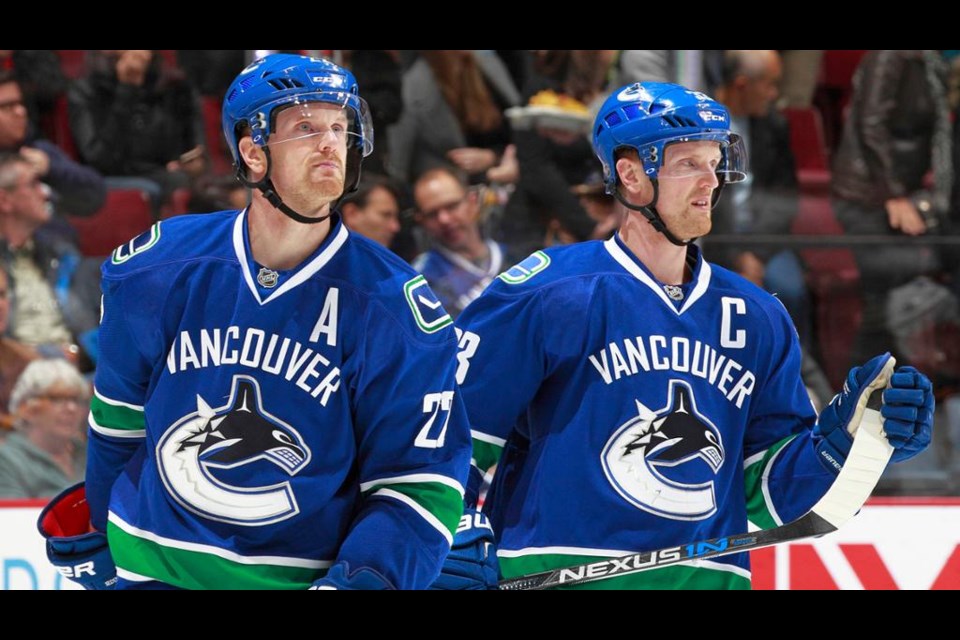According to multiple reports, the Canucks will be announcing Travis Green as the new head coach on Wednesday morning. Green has a tough task ahead of him: develop the Canucks’ young roster, while also finding ways to get more out of the team’s aging veterans.
He’ll also face the question asked of every Canucks’ coach every season for more than a decade: who will play with the Sedins?
At one point in time, this was the prime position. The Sedins were elite playmaking forwards that could elevate nearly anyone to at least a 20-goal season. It wasn’t necessarily an easy question to answer, however, as the usual suspects — big power forwards who could park themselves in front of the net and finish off passing plays — turned out not to be the best candidates for the job. Instead, scrappy two-way forwards like Alex Burrows and Jannik Hansen or fellow playmakers like Pavol Demitra and Mikael Samuelsson turned out to be more effective.
The Sedins are no longer the players they once were, however. They don’t just need the right linemate to bring out their best; they need the right linemate to even make them effective.
Their decline has become impossible to overlook or hand wave away: it was eminently clear to anyone who watched the Sedins last season that they’re no longer the first line forwards they once were. That said, their decline did not have to be anywhere near as precipitous as it has been.
The Sedins weren’t helped last season by a struggling power play that coaches Willie Desjardins and Doug Jarvis refused to change for fear of ruining their “chemistry.” Brandon Sutter finished with the third most power play ice time on the team: he had 8 power play points all season.
But it’s more than just the power play. The Sedins have seen a steady decline at even strength, producing their lowest points-per-60-minutes in a decade.

It’s interesting to look at Daniel and Henrik’s points-per-60 side-by-side. Henrik’s decline has been smooth and steady, while Daniel’s has been more erratic, either because his role as the designated goalscorer is fraught with more shooting-percentage-based randomness, or because of the accursed Duncan Keith. *spits*
Can the Sedins bounce back, even a little? Or can they at least level off a little bit and not get worse next year?
Yes. But it will depend a lot on who Travis Green sticks with the Sedins.
The Sedins played at least 80 5-on-5 minutes with six different linemates last season: Loui Eriksson, Jannik Hansen, Markus Granlund, Brandon Sutter, Michael Chaput, and Jayson Megna. It is my hypothesis — and it’s a controversial one — that at least a couple of those names really shouldn’t be on that list.
Here’s a chart of each of those linemates and some relevant statistics with the Sedins, as well as Alex Burrows and Nikolay Goldobin, who played fewer minutes but are included for what I think are obvious reasons.
| Linemate | TOI | CF60 | CA60 | CF% | C60 |
| Loui Eriksson | 326.81 | 58.02 | 46.63 | 55.44 | 104.65 |
| Markus Granlund | 175.13 | 52.42 | 43.85 | 54.45 | 96.27 |
| Michael Chaput | 107.58 | 47.96 | 44.06 | 52.12 | 92.02 |
| Alex Burrows | 32.09 | 59.83 | 59.83 | 50.00 | 119.66 |
| Brandon Sutter | 162.90 | 47.15 | 49.36 | 48.85 | 96.51 |
| Jannik Hansen | 120.91 | 55.08 | 61.53 | 47.23 | 116.61 |
| Nikolay Goldobin | 47.06 | 45.90 | 56.10 | 45.00 | 102.00 |
| Jayson Megna | 86.24 | 34.09 | 59.14 | 36.57 | 93.23 |
The chart includes time on ice (TOI), corsi for per 60 minutes (CF60), corsi against per 60 minutes (CA60), corsi for percentage (CF%), and total corsi per 60 minutes (C60). As a reminder, corsi = shot attempts. All statistics via corsica.hockey.
There are some surprises in this chart, which is sorted by CF%, ie. the percentage of total shot attempts taken by the Canucks with that linemate and the Sedins on the ice.
At the top of the chart is Loui Eriksson, who was signed last off-season partly because of his past experience playing with the Sedins for Team Sweden. He got off to a rocky start to the season, failing to score a goal in his first 13 games, except for on his own net.
With that lack of production, it’s understandable why Eriksson got bumped off the Sedin line, but there are some pretty clear signs that he should have had a longer leash. Eriksson put up the best CF% of any Sedin linemate last season and also the second highest number of shot attempts per 60 minutes. That’s the kind of puck possession that eventually leads to point production, but it’s hard to be patient when it doesn’t get results in the short term.
Markus Granlund was nearly as good as Eriksson, but he’s a bit more of a low-event player: fewer shot attempts for, but also fewer shot attempts against as compared to Eriksson. If Travis Green turned to Granlund to play with the Sedins next season, I wouldn’t get bent out of shape.
The only other Sedin linemate above 50% in CF% is a surprising name: Michael Chaput. The fourth-liner got promoted up the lineup and got kudos from his coach and some media members, who claimed to see a bit of Alex Burrows in Chaput. But while Chaput was better than you might expect with the Sedins, he also had a detrimental effect on their offence.
You can see that by comparing him to Burrows, next on the list: with Burrows, the Sedin line had nearly 12 more shot attempts per 60 minutes than with Chaput. If the Canucks want any offence out of the Sedins at all, then Chaput is not the answer on the Sedins’ line.
Neither is Brandon Sutter, who isn’t quite as low-event as Chaput, but still deadens the Sedins’ offence. He allows more shot attempts against than any of Eriksson, Granlund, or Chaput, while not making up for it in the offensive end.
The biggest surprise for me is Jannik Hansen. While he shows well in shot attempts for, right behind Burrows and Eriksson, the Sedins gave up more shot attempts against with Hansen than with any other linemate. That’s a big surprise considering their strong season together last year and how good they were together over multiple seasons.
Hansen isn’t an option for Green, but the player brought back in his trade is. That would be Nikolay Goldobin, who had some good moments with the Sedins late in the season, but doesn’t look good in terms of corsi, giving up a ton of shot attempts against and producing few shot attempts for.
There are three caveats here: the first is sample size, as Goldobin played just over 47 even-strength minutes with the Sedins. The second is age, as Goldobin is just 21 and has a high ceiling and time to reach it. With an off-season to train and a pre-season to develop some chemistry, Goldobin would be an intriguing choice to start the season with the Sedins, if not the safest option.
Then there’s Jayson Megna. I don’t know how he managed to last 86+ minutes with the Sedins. He failed the eye test on that line and really failed the analytics test. He completely killed the Sedins’ offensive game and was terrible for them defensively. It is inexplicable that he played more than one shift on their line.
While the Sedins’ linemates this past season don’t entirely explain away their struggles, it does provide some optimism that they might be able to at least be a solid second line next season with better linemates.
Eriksson and Granlund should be Green’s go-to options, but he’ll have a number of young players that he can put in that role. Goldobin should get a shot, but Brock Boeser is an option as well, with wildcards like Jonathan Dahlen, Reid Boucher, and (why not?) Jake Virtanen waiting in the wings.
Just, for the love of all that is holy, Travis Green: keep Megna away from the Sedins.



